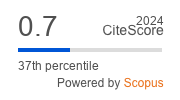Reviewer guidelines
The Responsibility of the Peer Reviewer
The peer reviewer is responsible for critically reading and evaluating a manuscript in their specialty field, and then providing respectful, constructive, and honest feedback to authors about their submission. It is appropriate for the Peer Reviewer to discuss the strengths and weaknesses of the article, ways to improve the strength and quality of the work, and evaluate the relevance and originality of the manuscript.
Before Reviewing
Please consider the following: Does the article you are being asked to review match your expertise? Do you have time to review the paper? Are there any potential conflicts of interest?
The Review processes
When reviewing the article, please keep the followings in mind:
- Content Quality and Originality, Clarity, Novelty, Scientific reliability, A valuable contribution to the science, adding new aspects to the existed field of study, Ethical aspects, Structure of the article submitted and its relevance to authors’ guidelines, References provided to substantiate the content, Grammar, punctuation spelling, and Scientific misconduct.
- The title: Does it clearly describe the article?
- Abstract: Does it reflect the content of the article?
- Introduction: Does it describe what the author hoped to achieve accurately, and clearly state the problem being investigated? Normally, the introduction should summarize relevant research to provide context and explain what other authors' findings, if any, are being challenged or extended. It should describe the experiment, the hypothesis(es), and the general experimental design or method.
- Method: Does the author accurately explain how the data was collected? Is the design suitable for answering the question posed? Is there sufficient information present for you to replicate the research? Does the article identify the procedures followed? Are these ordered in a meaningful way? If the methods are new, are they explained in detail? Was the sampling appropriate? Have the equipment and materials been adequately described? Does the article make it clear what type of data was recorded; has the author been precise in describing measurements?
- Results: It should be clearly laid out and in a logical sequence. You will need to consider if the appropriate analysis has been conducted. Are the statistics correct?
- Conclusion/Discussion: Are the statements in this section supported by the results, do they seem reasonable? Have the authors indicated how the results relate to expectations and earlier research? Does the article support or contradict previous theories? Does the conclusion explain how the research has moved the body of scientific knowledge forward?
- Tables, Figures, Images: Are they appropriate? Do they properly show the data? Are they easy to interpret and understand?
Ethical Issues:
- Plagiarism: If you suspect that an article is a substantial copy of another work, please let the editor know, citing the previous work in as much detail as possible
- Other ethical concerns: For medical research, has confidentiality been maintained? Has there been a violation of the accepted norms in the ethical treatment of animal or human subjects? If so, then these should also be identified to the editor. Please complete the “Reviewer’s Comments” form by the due date to the receiving editorial office. Your recommendation regarding an article will be considered when the editors make the final decision, and your thorough, honest feedback will be much appreciated.
Important notes:
- If you would like to discuss the article with a colleague, please ask the editor first.
- Please do not contact the author directly.













